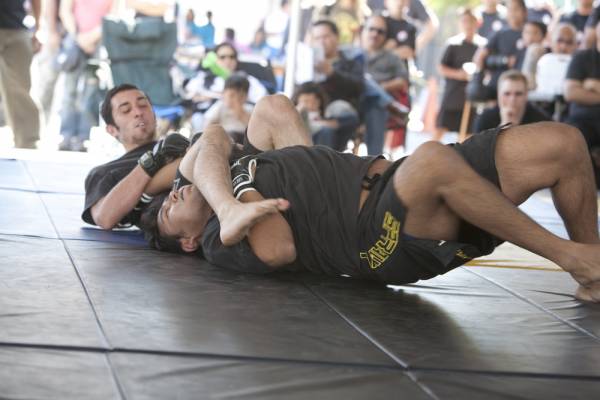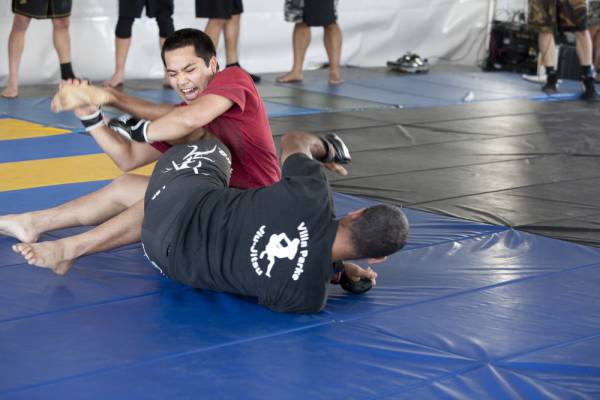One of the best parts of my job as an auditor is that I get to visit companies in lots of different towns and cities. While I enjoy all the new shopping opportunities that provides, my favorite part is that I get to visit other Brazilian jiu jitsu clubs.
During the planning phase of my travels, of course I have to focus on the company at which I will be working. But I also try to do some research on the local jiu jitsu scene to find out how many clubs there are and which one(s) might best suit my needs. The search can be the hardest part.
How to Find a Club
If members of your team aren’t able to recommend a club in the town you’re visiting, a great way to locate BJJ clubs is to post a question on Facebook. Maybe a friend will be able to refer you or knows someone else who can. Facebook groups like the Women’s Grappling Network can connect you to women all around the world. If that doesn’t lead you to any answers, you can try a Google search or post the question on Sherdog or Reddit.
“Remember: you’re not only representing yourself – you’re also representing your team and your home academy.”
Once you’ve narrowed down a few options, you can read reviews for the clubs on YELP, look up their websites, and contact them to find out about schedules and pricing. It’s always better to confirm the details before showing up to a club, just in case operations have changed, but the website hasn’t.
Things to Consider in Choosing a Club
Each BJJ academy is different and when you visit a new one, it’s best to adapt to their culture for the duration of your stay. For example, do they clap when breaking away from the instructor to learn technique? Do they bow before stepping on or off the mats? Can students ask higher-ranked belts to roll or do they wait to be asked? How do they begin a match? How do they line up after class? Do they have any club rules? Is there a particular gi color required?

Sometimes you can figure out the answers to these questions by looking at photo galleries on a club’s website, and some schools have their rules posted online. While writing this article, I did a search of rules for different BJJ schools and the following were consistently present:
- Show up a little early to take care of any payments or paperwork.
- Ask the instructor if any submissions are prohibited.
- Do not speak or interrupt the instructor as he or she is teaching.
- Do not use foul language.
- Do not be overly aggressive when rolling with other students and do not wait too long to tap.
- Bring enough gis to ensure you have a clean one for each class, or find out where you can wash your gi between classes. Make sure your gi is free of rips or tears.
- Err on the side of modesty. For no gi, do not wear sleeveless tops or hot pants. Wear a rashguard and board shorts, gi pants, or spats. (I would suggest this regardless. Would you want a big tuft of sweaty armpit hair on your face? Me either.)
- Wear a mouth guard.
- Ensure you have fresh breath and no body odor. Wear deodorant.
- Cut your fingernails and toenails.
- Remove all transferable cosmetics and jewelry.
- Tie your hair back. (I recommend braiding for long hair to keep it a secure as possible.)
- Bring flip-flops to wear off the mats.
- Shower as soon as possible after class.
Rolling as a Visitor
When I roll with people I don’t know, I am very cautious. It could be because I’m a lot smaller than most people, but I am always nervous about getting hurt due to clumsiness, aggression, or unknown tactics. Big white belts are on my “do not roll” list for exactly that reason. I’ve missed so much time due to various injuries that I will do whatever it takes to stay healthy. Although it can feel bad to say no to rolls, I recommend that other travelers make safety a priority, as well.

Remember when you do roll, your partner will reflect your intensity. If you come on hard and fast, your partner may do the same. If you ease into the roll, your partner will usually do so, as well. Once you get a feel for your new rolling partner, you may be able to have a normal roll, but I highly recommend a feeling-out process.
“Remember when you do roll, your partner will reflect your intensity. If you come on hard and fast, your partner may do the same. If you ease into the roll, your partner will usually do so, as well.”
Also, it’s not a tournament. It’s just a class. If you find your BJJ is at a higher level than your partner, it’s probably not polite to tap him or her seven times in five minutes. It’s kinder to allow the person to work on their game, too. Remember: you’re not only representing yourself – you’re also representing your team and your home academy. It’s best to not be an asshole, if possible. If you’re the one getting tapped seven times in five minutes, it sucks – but hey, it was only five minutes out of your life. And hopefully you learned a thing or two.
My Experience
To date, I have thoroughly enjoyed training at every club I’ve visited on the road. The BJJ community is so friendly and welcoming, and it is always a pleasure to meet fellow practitioners and learn from them. Just do your homework before picking a club, mind your manners and their rules, be a good training partner (as you always should be anyway), and you’ll do fine.
We also love having visitors at Titans so if you’re ever in Nova Scotia, be sure to stop in and see us!
You Might Also Enjoy:
- 10 Survival Tips for Visiting a New Grappling Academy
- Don’t Stink and Wash Often: Hygiene for BJJ Gyms and Athletes
- Tips for Choosing a BJJ Academy
- What’s New on Breaking Muscle Today
Photos courtesy of Shutterstock.






